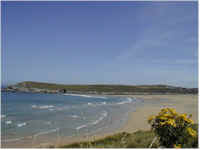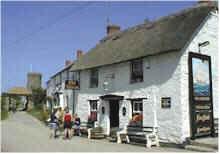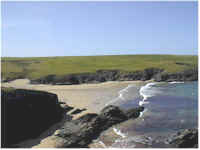



Crantock is a picturesque village, separated from the busy tourist town of Newquay by the River Gannel. Today the village has picturesque cottages, couple of art and craft shops, tea garden, and a couple of pubs.
Large parts of the parish are now in the ownership of the National Trust, including the West Pentire headland ( Site of Special Scientific Interest, SSSI). On this headland can be found the the Bowgie Inn with views from the bar of the Gannel estuary, beach, Goose Rock and the open sea beyond.
A very old village, dating from early christian times. It was named after St Carantoc, who founded an oratory here in the 5th century. Apparently a storm blew the saint into the Gannel Estuary, and a dove that he had with him dropped a twig in the sand dunes on the site for his oratory to give thanks for his deliverance. The oratory eventually became a College of Priests, which was a centre of religious learning until it was destroyed during the Dissolution of the Monasteries by Henry VIII. A survey of 1294 showed the religious college having large revenues.
There is a legend that a city called Langorroc ( 'The Dwelling of Monks' for it was a major centre of religious activity before the Norman conquest) prospered here until the citizens grew too lazy, and an apocalyptic sand storm buried the city and its inhabitants. They say the proof is in the fact that local farmers plough up bones in the sandy soil (equally well, of course, the bones could come from the old graveyard that must have been associated with the monastery the Henry VIII destroyed)

The parish church, a Norman building, was restored at the beginning of the 20th century. it has some fine woodcarving, particularly its carved rood screen. The history of St Carantoc is told in the stained glass windows.
The original the village stocks (last used in 1817 to punish a smuggler) are found round the back of the church.
The Old Albion is a fine thatched pub right beside the church and is invariably the "Cornish Pub" that you will find in all the anthologies of Cornwall.
The Round Garden has been given to the National Trust and is believed originally to have been a pound for animals that strayed from the local common. Today it is an orchard with a hedge and trees that enclose an open area of grass with a bench. It also makes a roundabout in the centre of the village although it is not used as such. It is believed to be the site of one of the seven Celtic chapels which surrounded the original church.
The Crantock Gallery specialises in paintings of pets by artist Marion Rowland.
Village Green with a well and a small Memorial Hall to commemorate those who died in the two World Wars.

South West Coast Path runs round around West Pentire headland to Polly Joke. A really lovely cove, entirely surrounded by National Trust land, completely undeveloped, and unspoilt (the nearest car park being hundreds of yards away, is enough to keep the masses away). It got its name from the old Cornish words for 'Jackdaw Cove' ....'Pol-Lejouack'.